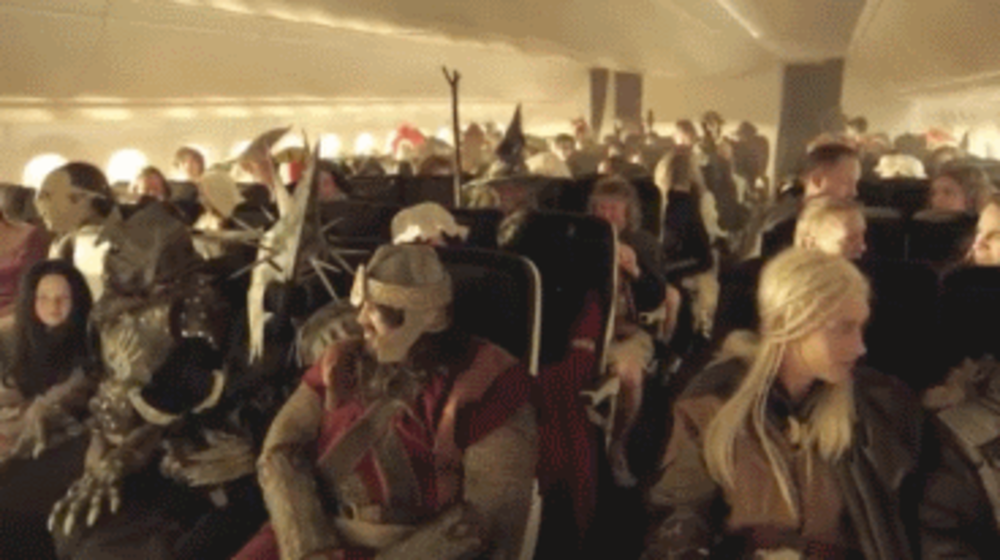The Objective: The world is indeed full of peril and in it there are many dark places—but online advertising shouldn’t be one of them. That’s the thinking behind Air New Zealand‘s online ad strategy.
“It’s a fact that click-through rates are continually decreasing—the average click-through rate for an online ad is at about .08 or .09%,” says Evette Mesrobian, director of West Coast sales at ad tech company Spongecell, which powered a recent Hobbit-themed campaign for Air New Zealand. “So the question is how can we communicate with those 99% of people who aren’t clicking on ad units?”
The answer is interactivity, says Tritia Cantun, online marketing manager at Air New Zealand. The brand started working with Spongecell about a year ago to make its online ads more dynamic.
“The one thing we were really pushing towards was bookings,” says Cantun. “Everything we do in this market is direct-response and revenue focused.”
The Strategy: To accomplish that, Air New Zealand used the Spongecell platform to create “fare-finder” ad units with deep links that allow visitors to research flights within the ads themselves.
“For us, it’s all about getting consumers into the booking flow as quickly as possible,” Cantun says of the ads. “Instead of having to view the ad, click on it, then get taken to a landing page, and then finally go to the booking engine, you can do it all at once—which makes people more likely to book.”
The ads were part of a three-part series of Hobbit-related promotions that ran between November 2012 and January 2013, tapping into the massive popularity of The Lord of the Rings franchise.
In phase one Air New Zealand launched the fare-finder units along with a global sweepstakes that gave entrants the chance to win tickets to the premiere of The Hobbit in Wellington, New Zealand, as well as a personal tour of director Peter Jackson’s workshop and film locations—a “‘money can’t buy’ kind of experience,” Cantun says.
As part of the second phase, Air New Zealand created an imaginative Hobbit-themed safety video in which an elfin stewardess explains safety procedures to a plane full of elf, dwarf, and wizard passengers. Peter Jackson himself even has a cameo.
The brand also released a ‘making of’ video with behind-the-scenes footage from the safety video shoot.
For the final phase, Air New Zealand acquired exclusive b-roll footage from Warner Brothers, including pre-production shots from the initial location scouting and extra unreleased scenes from The Hobbit, all of which was integrated into the fare-units. The brand also wrapped Air New Zealand planes with images from the movie and created a time-lapse video showing how it was done.
“But the content didn’t interfere with the booking process,” said Cantun. “It sat behind the units, so people could access it without getting distracted from the task at hand.”
Also noteworthy, the fare-finder ads function as “evergreen units,” says Spongecell’s Mesrobian, meaning Air New Zealand didn’t have to worry about keeping the flight information advertised in the ads up-to-date and in compliance with Department of Transportation regulations—that happened dynamically.
“Everything is deep-linked to the program site where all the information is already approved and OK, so you can have these ad units up all year long without having to change anything other than the background image or the text,” Mesrobian says.
The Results: According to Air New Zealand, the Hobbit Spongecell units performed four times better than the brand’s global ROI benchmark.
During the Hobbit campaign, Air New Zealand ran a simultaneous series of ads, not through Spongecell, that clicked through to a landing page rather than deep linking directly to the booking site. The deep-linked ads had a 26% higher click-through rate and a 25% higher conversion rate than the non-Spongecell ads.
The Customer View: YouTube comments on the safety video ranged from effusive to downright ecstatic: One viewer gushed: “Can’t help but smile at this. I went to New Zealand and cried tears of joy when this came on” while another said: “I’ll take a lifetime supply of tickets please.”
The Takeaway: Although the ads brought in a significant amount of traffic, the goal was less about volume quantity than volume quality, says Mesrobian.
“For the brand, the ads help consumers down the purchase funnel and improved the quality of user,” she says. “For the consumer, it streamlines the experience and eliminates extra steps.”








